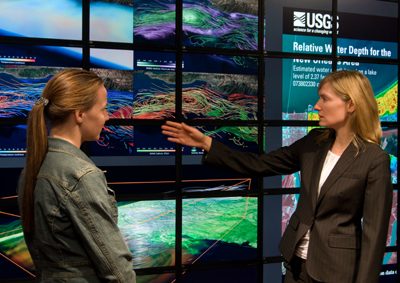Supercomputing ’07 - SC07
November 10th, 2007 - November 16th, 2007
Categories: Applications, Data Mining, Devices, Networking, Software, Supercomputing, Visualization

About
At this year’s SC07, the University of Illinois at Chicago’s Electronic Visualization Laboratory (EVL), California Institute for Telecommunications and Information Technology (Calit2), Scripps Institution of Oceanography and San Diego Supercomputer Center (SDSC) are “Inventing the Future with Cyberinfrastructure.” The “team” will display their current projects in a joint booth at the conference.
Together with global scientific communities and industrial partners, they are creating multidisciplinary teams, tools, hardware, software, and human-interface models that underpin cyberinfrastructure for data-intensive research and collaboration. This team provides technological leadership in: high-performance TeraGrid and grid computing, data management and storage, optical networking, and visualization, virtual-reality and collaboration technologies, and partner with computational scientists and computer scientists to maintain competitive advantages and accelerate scientific innovation and discovery.
Please click the following link for a full text article on the partnership and the SC07 event:
Calit2, SDSC, Scripps and UIC / EVL Showcase Cyberinfrastructure Future at SC07
SC07 is the premier international conference on high performance computing, networking, storage, and analysis. SC07 is expanding the frontiers of High Performance Computation by introducing a new cluster challenge that combines the computation, networking, storage, and analysis elements into a single competition.
SC07 provides attendees the opportunity to speak with industry and academic research leaders through the technical program, industry exhibits, research exhibits and Birds-of-a-Feather sessions.
The SC07 Education Program is designed to work with undergraduate faculty, administrators and college students to integrate computational science and the high performance computing and communications technologies highlighted through the SC Conference into the preparation of future scientists, technologists, engineers, mathematicians and teachers.
The following EVL projects were displayed in the SC07 booth.
Tellurion
Tellurion is a real-time planetary-scale data visualization. It uses a GPU-based algorithm to adaptively tessellate the sphere and apply terrain displacement, composing height field images of arbitrary resolution and projection. A deferred rendering approach combines per-pixel illumination and atmospheric effects for added realism.
LambdaVision
LambdaVision is an ultra-high-resolution visualization and networking instrument connected to high-bandwidth optical networks, and designed to support collaboration among co-located and remote experts. It is a 55 LCD panel tiled array driven by a 32-node cluster with a combined resolution of over 105 Megapixels.
www.evl.uic.edu/cavern/lambdavision
SAGE (Scalable Adaptive Graphics Environment)
SAGE enables researchers to create real-time shared “cyber-mash-ups” of extremely high-resolution content on scalable tiled display walls over high-speed networks, including stored scientific-visualization movies, real-time generated visualizations of computational simulations, and camera-based streams.
The SAGE architecture uses distributed rendering clusters connected by high-bandwidth networks to stream multiple applications to a class of scalable tiled displays that are fast becoming a standard for scientific distance collaboration.
Using SAGE, several applications - including high-resolution 2D imagery, 3D computer graphics and high definition video - can be streamed and viewed simultaneously. SAGE is being developed by the Electronic Visualization Laboratory at the University of Illinois at Chicago as part of the National Science Foundation-funded OptIPuter project.
www.evl.uic.edu/cavern/sage
Lambda Table
Lambda Table is a tiled LCD tabletop display connected to high-bandwidth optical networks that supports interactive group-based visualization of high-resolution data.
Lambda Table’s camera tracking system is a scalable multi-camera computer vision architecture designed to track input from many simultaneous users interacting with a variety of different interface devices.
Lambda Table is a 6 LCD panel tiled array driven by a 7-node cluster (including tracking) with a combined resolution of 24 Megapixels.
www.evl.uic.edu/cavern/lambdatable/